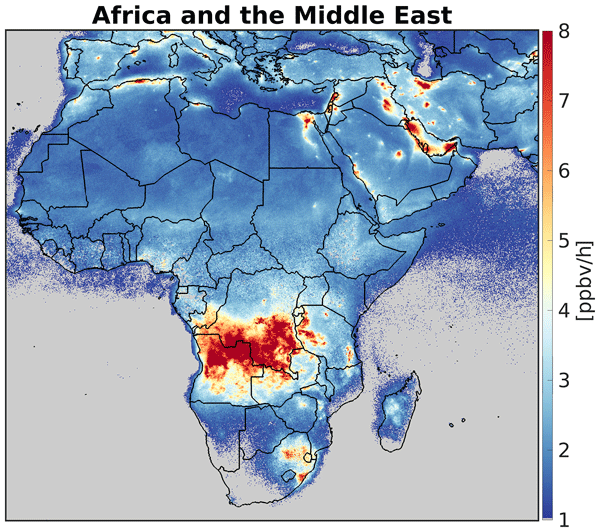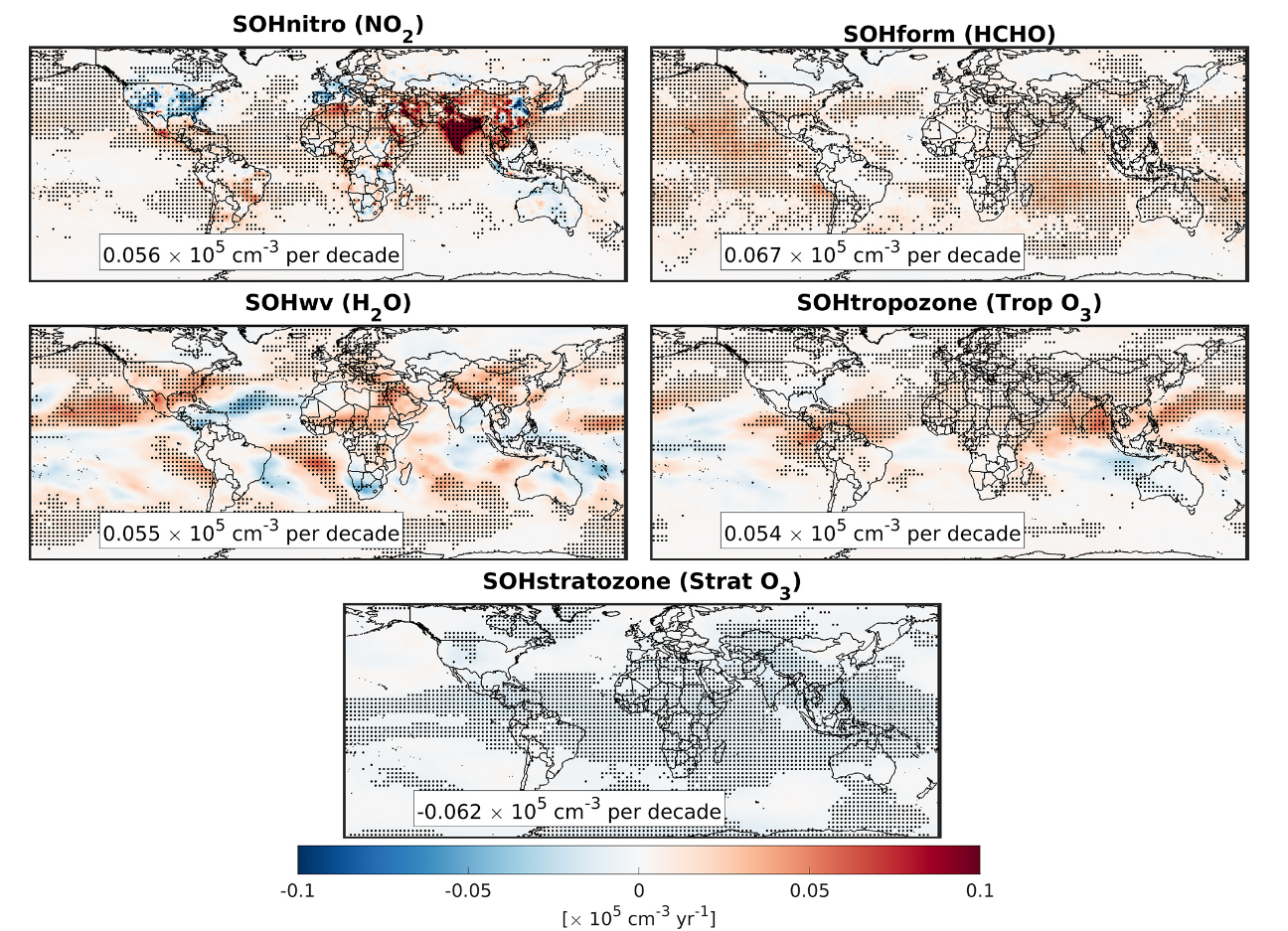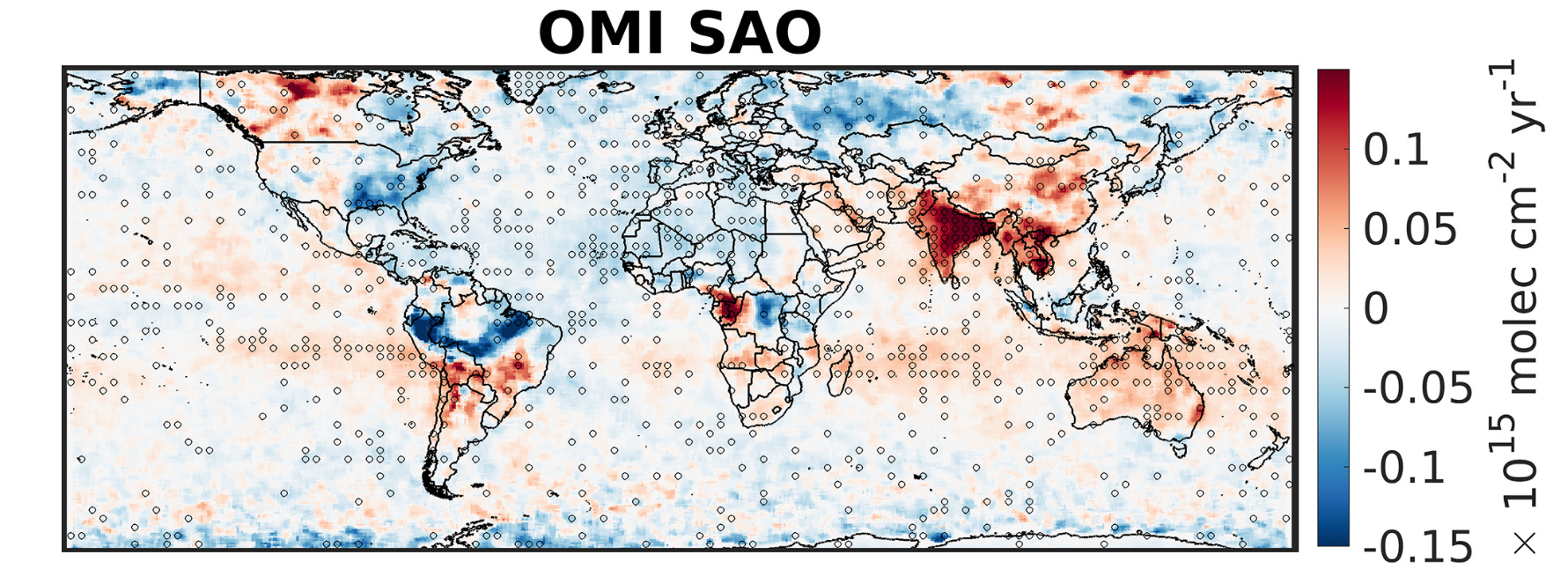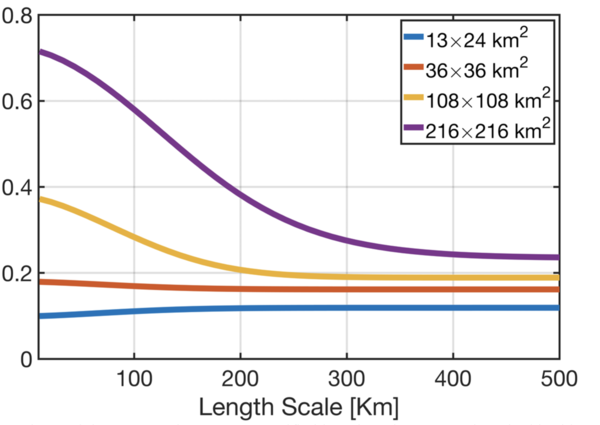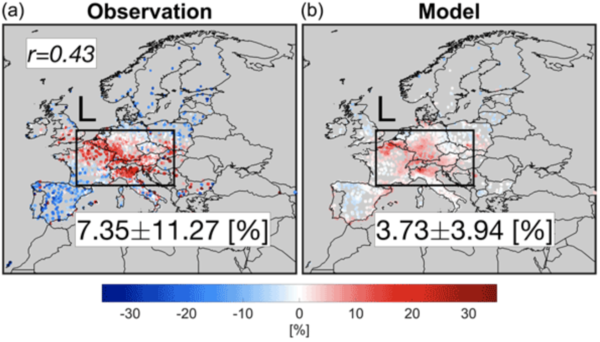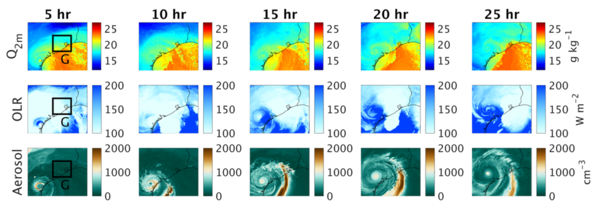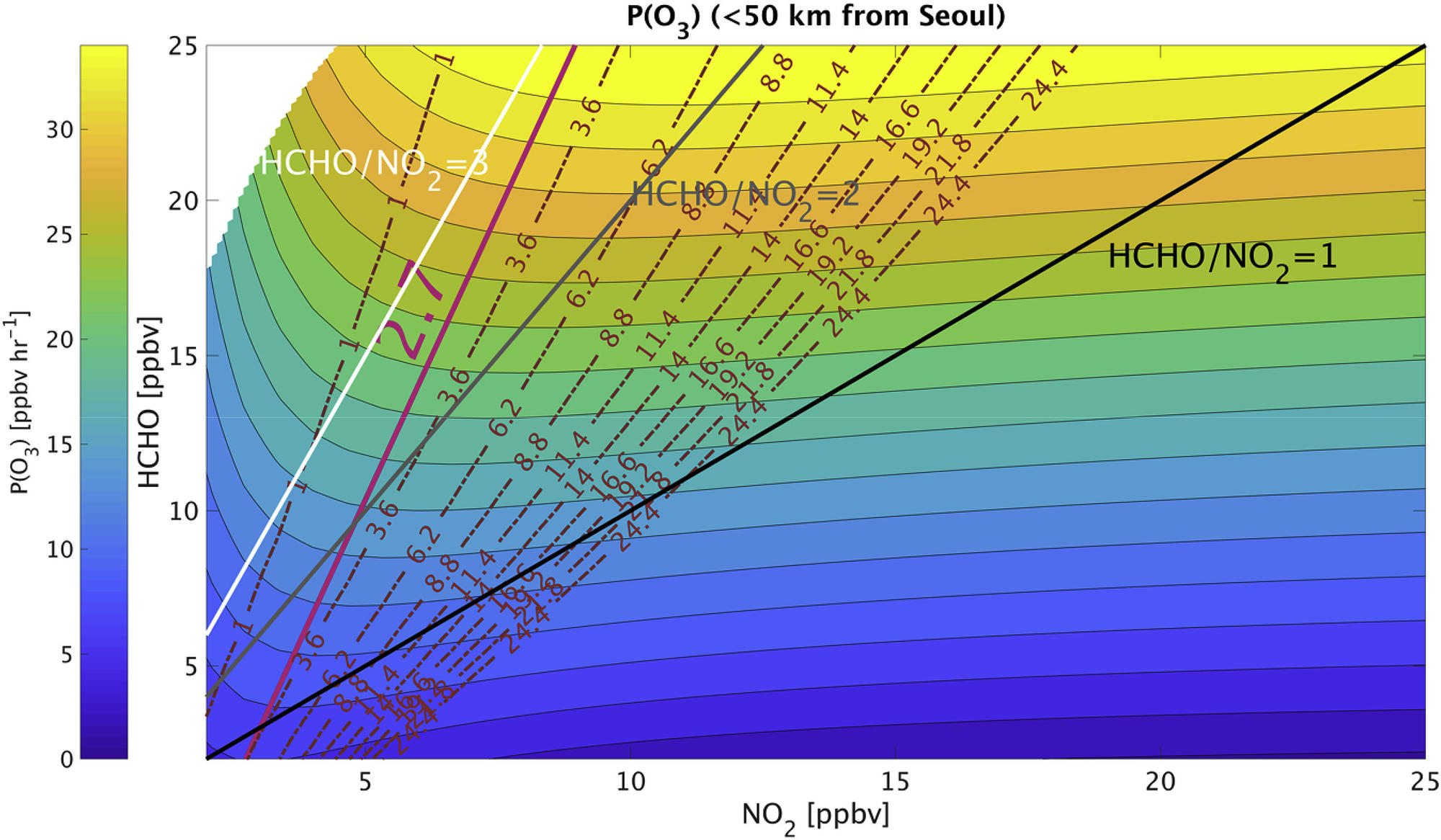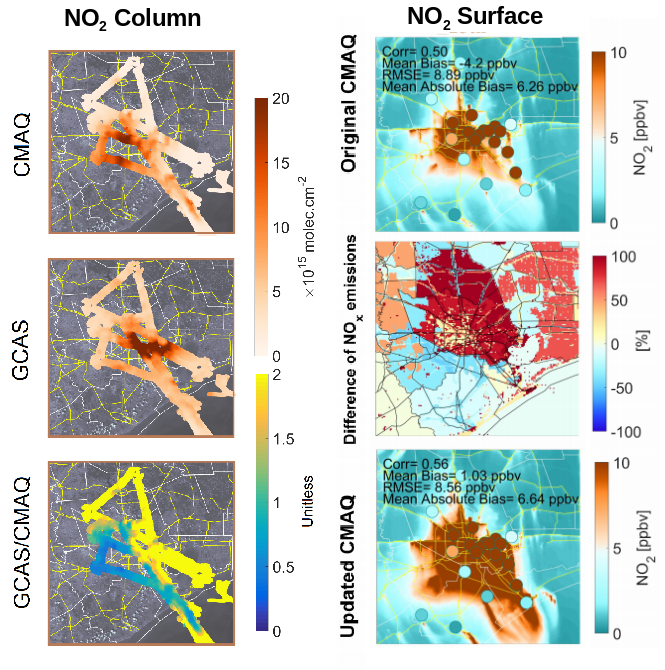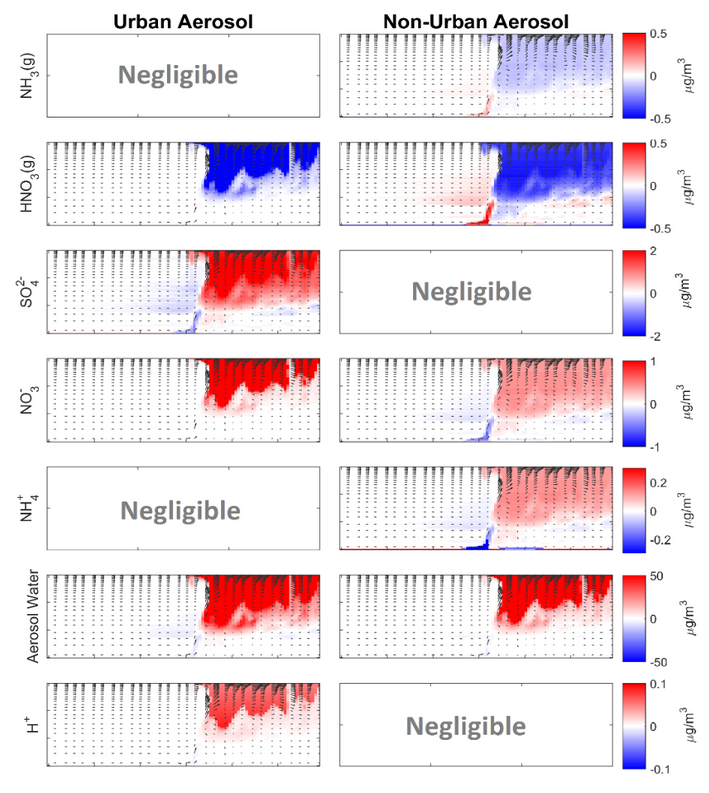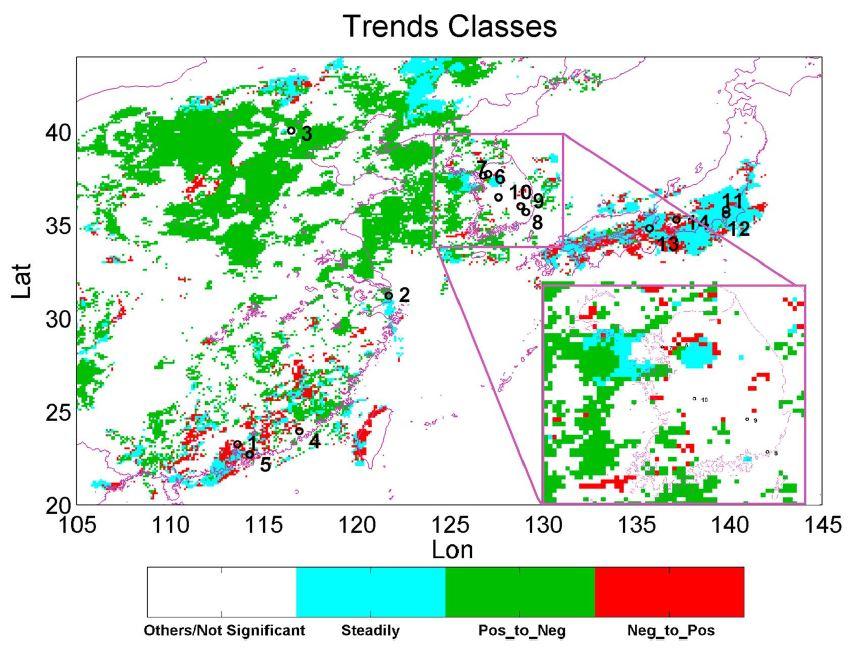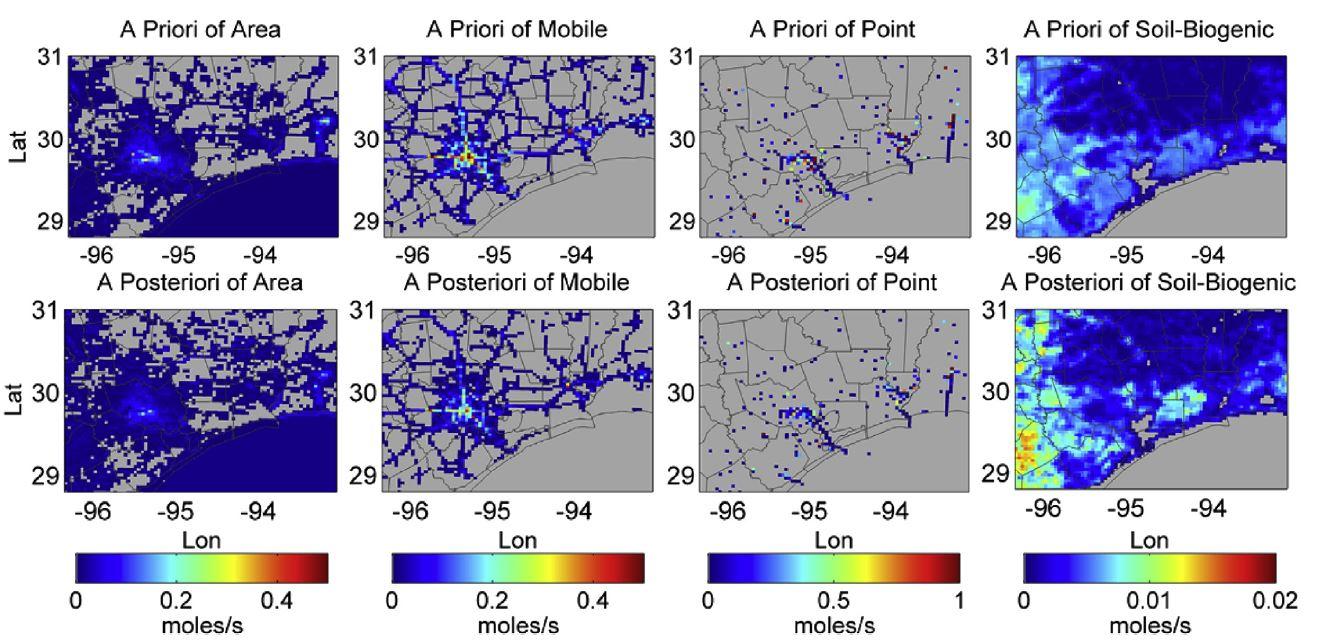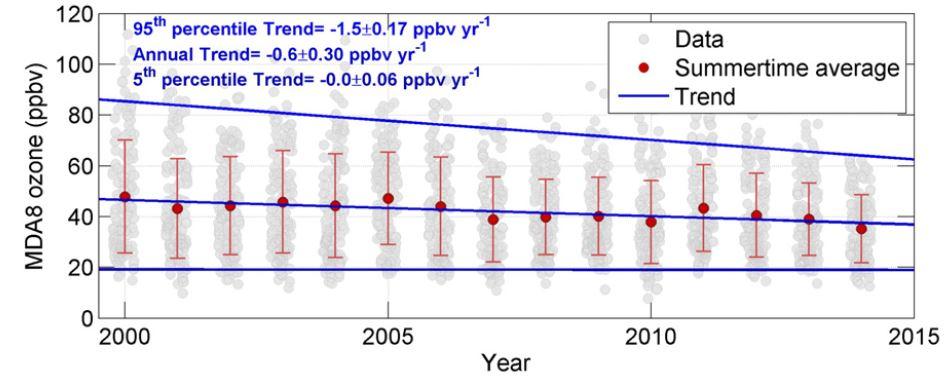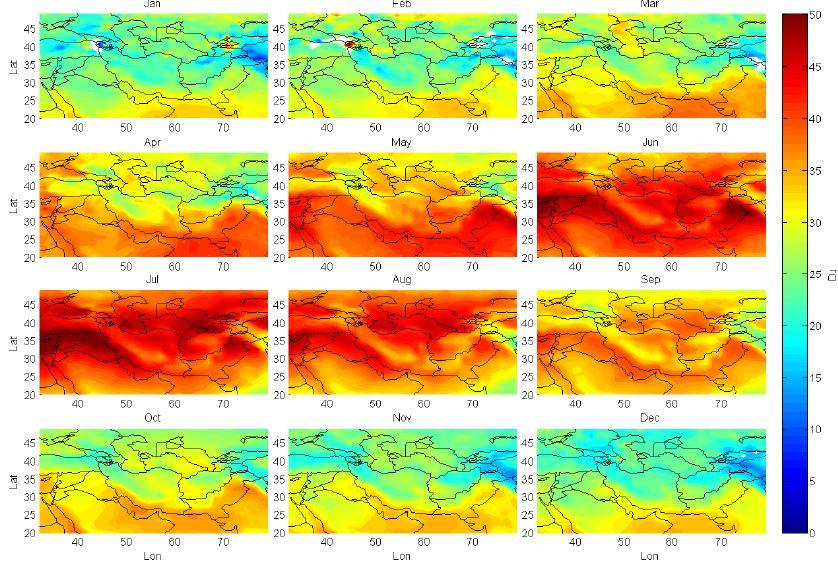Research
First Estimates of Net Ozone Production Rates Determined by Satellite Observations
Please take a look at here for more information. |
We establish a simple yet robust relationship between ozone production rates and geophysical parameters obtained from several intensive atmospheric composition campaigns. We show that satellite remote sensing data can effectively constrain these parameters, enabling us to produce the first global maps of ozone production rates with unprecedented resolution. Not only do these maps provide the magnitudes of PO3 but also the algorithm can break down the varying sensitivity of PO3 to NOX and VOC providing much finer information relative to what previously could be achieved using FNR. |
Improving the representation of tropospheric OH trends using satellites and machine learning
Please take a look at here for more information. |
We explore a new method of using the wealth of information obtained from satellite observations of Aura OMI NO2 (NASA GSFC), HCHO (v4, SAO), and MERRA-2 reanalysis in NASA’s GEOS model equipped with an efficient tropospheric OH (TOH) estimator using XGboost to enhance the representation of TOH spatial distribution and its long-term trends. This new framework helps us pinpoint regional inaccuracies in TOH and differentiate between established prior knowledge and newly acquired information from satellites on TOH trends. |
Long-term maps of HCHO total column from OMI SAO (v4)
Please take a look at here for more information. |
Using the state-of-the-art OMI HCHO retrievals we show the widespread upward trends in HCHO over India due to a lack of effective efforts to cut emissions related to VOCs. We observe HCHO columns going up in the northwestern US and over oil sands in Canada, possibly due to increased evergreen needleleaf forests and an increase in crude oil production, respectively. The downward trends over the southeastern US could be due to a decrease in drought events, which significantly affect isoprene emissions and the oxidation of VOCs. Alternatively, this downward trend could be partially due to the dampened HCHO production from VOC oxidation due to reduced NOx emissions. In agreement with previous studies HCHO columns increase over the NCP. HCHO columns tend to decrease over parts of central Africa (e.g., the Democratic Republic of the Congo) and the Amazon basin, potentially due to reduced deforestation rates. However, large variability in the signs of HCHO trends over these regions is seen: Congo shows an opposite trend to that of the Democratic Republic of the Congo, and the northern portion of the Amazon basin has an increasing trend. |
Unsual vertical shapes in HCHO profiles and their negative effects on the retrievals
Please take a look at here for more information. |
Using a regional atmospheric model, we study the impact of sea breeze circulation on formaldehyde (HCHO) concentration profiles along the east coast of the U.S. The contrasting thermal conditions between the ocean and the land led to distinct air flows: clean marine air close to the surface, and polluted continental air at higher altitudes. This resulted in unusual vertical patterns of HCHO concentrations leading surface and total column HCHO to exhibit a negative correlation. We compared two models and found significant differences in their representation of sea breeze timing and strength, resulting in discrepancies in HCHO vertical distribution. The misrepresentation of HCHO vertical shape by one model caused a 20–30% error in total HCHO column abundances and 50-120% in column-to-surface translation. Such errors may adversely impact satellite-based air quality applications, highlighting the importance of well-tuned atmospheric models for reliable satellite retrievals under local circulation patterns like sea-land breezes. This is particularly crucial for TEMPO whose retrievals rely on accurate representation of vertical shapes at hourly timesteps through the diel cycle. |
Breaking down errors in satellite-based HCHO/NO2 ratios
Please take a look at here for more information. |
Advancements in satellite remote-sensing of formaldehyde (HCHO) and nitrogen oxide (NO2) compounds have encouraged many to utilize columnar HCHO/NO2 ratios to diagnose ozone (O3) regimes meaning if the ozone production rates are sensitive to NOx (i.e., NOx-sensitive) or VOC (i.e., VOC-sensitive). We show such a diagnosis cannot be performed in a robust manner unless we carefully quantify/mitigate four major sources of error: i) inherent chemical uncertainties associated with the approach of FNRs to diagnose sensitivity regimes (20% error), ii) the capacity of tropospheric column satellite retrievals to represent the PBL- or surface-level environment (19-37% error), iii) spatial representativity of ground pixels of satellite sensors (12-50% error), and iv) uncertainties associated with satellite-retrieved column-integrated concentrations of HCHO and NO2 (50-250%). We address all of them using a broad spectrum of tools and data. Furthermore, we will introduce a new metric that can be used in conjunction with the ratio to estimate the magnitude of PO3 — a pivotal quantify critical for understanding the spatial and temporal variability in locally-produced PO3. |
Mathematically representing the spatial representation error
Please take a look at here for more information. |
A critical error in the satellite-based observations or model-based fields is from unresolved spatial variability in trace gas concentrations within a satellite pixel or a model grid (Souri et al., 2022). The amount of spatial variability which is unresolved, or the representation error, can in principle be modeled if we base our reference on a distribution map made from a high spatial resolution dataset. We developed a method based on modeling isotropic semivariogram to quantify the amount of spatial information lost for different ground pixel sizes and length scales. Our method is compelling to understand and easy to apply to other products and different atmospheric environments. We developed an open-source package called SpaTial Representation Error EstimaTor (STREET) (https://github.com/ahsouri/STREET) based on this approach for everyone to use. |
The problem of scale
Please take a look at here for more information. |
A fundamental taboo in satellites (and models) validation against pointwise measurements is the problem of scale: If one compares a grid box to a point sample, they are assuming that the point is representative of the grid; is such a comparison ever logical, in the sense that the average of the spatial distribution of the underlying compound is represented by a single value measured at a subgrid location? We leveraged some geostatistical tools to transform discrete points to gridded data with quantified uncertainty, comparable to satellite footprint (and response functions). This in part alleviated some complications concerning point–to-pixel comparisons. |
Why is surface ozone much higher during 2020 lockdown in Europe?
Please take a look at here for more information. |
Everyone can guess that the reduced human activities due to the pandemic should have a large impact on air pollution, but the challenge is to carefully quantify these changes and pinpoint which chemical and physical processes are involved in shaping primary and secondary pollution levels. |
A delicious soup is made; ingredients: NO2 and HCHO, recipe: non-linear Gauss-Newton joint inverse modeling
Please take a look at this link for more information. |
Interconnectedness is a core characteristic of atmospheric composition and yet is frequently ignored in the area of inverse modeling and data assimilation. There are few attempts to incorporate multi-sensors/multi-species in a way to properly consider the tangled relationships between atmospheric compounds such as the potential effect of oxidation and lifetime of one on another. For the first time, we provide a joint optimal estimate of NOx and NMVOC emissions during the KORUS-AQ campaign by simultaneously incorporating both SAO's new product of HCHO columns from OMPS and OMI tropospheric NO2 columns into a regional chemical transport model. Results demonstrate a promising improvement in the performance of the model in terms of HCHO and NO2 concentrations, which in turn, enable us to quantify the effect of the emission changes on different pathways of ozone formation/loss over East Asia relative to 2010 |
Corn Sweat contributed to strong mugginess (up to 40% increase in specific humidity) during a heatwave event
Please take a look at this link for more information. |
We conducted a top-down constrained weather model using satellite observations during an intense heatwave occurring in the Midwest in 2011. We found that corn sweat (i.e., transpiration from cornfields) contributed to augmenting specific humidity up to 40% resulting in the total water vapor columns around 40 mm above the climatological values. As such, crops contributed to mugginess and induced a strong radiative forcing (14 Wm-2, equivalent to an 0.4oC enhancement of the ambient air temperature) due to the fact that water vapor is a potent greenhouse gas. |
Air Pollution invigorated Harvey's convective activities over Houston
First row: the simulated water mixing ratio at 2 m, starting from 03 UTC 26 August for the SP experiment. Second row: OLR for detecting the cloud location. Third row: the aerosol concentrations at a 2 km altitude. Please take a look at this link for more information. |
A number of human-induced elements contribute to strengthening the intensity of tropical cyclones and prolonging their lifetime. Not only do ocean heat content, large-scale weather patterns, and surface properties influence the amount of release of energy, but the modulation from aerosol particles on cloud properties is also present. In warm-phase clouds, aerosols generally provide relatively large particles and/or lower vapor pressure surfaces, thereby facilitating the condensation of water vapor. Due to the non-linear processes involved in clouds microstructure, aerosol properties and the variability associated with the atmospheric environment, the quantification of the response of storms to aerosols is difficult. We used state-of-the-art chemical and weather models to quantify the impact of human-made aerosols on the amount of precipitation by Hurricane Harvey (2017). Results from the models suggest that a narrow band of polluted air from western Texas was transported over the Houston greater area at the moment when the convective system was active, intensifying the storm which led to an increase in rainfall by 8% (25 mm) on average. We show that the consequences of air pollution extend beyond health issues and reduced crop yields. As such, controls on emissions with respect to exacerbating severe weather should be more encouraged. |
Too much feedback can kill you: Reformulating a widely used indicator for ozone sensitivity
The P(O3) isopleths as a function of NO2 and HCHO concentrations overlaid by the LNOx/LROx contours (purple lines). Please take a look at this link for more information. |
Ozone formation is a non-linear function of NOx and VOC concentrations. So, a large number of proxy indicators have been proposed to know which precursor is the major driver for the formation/loss of ozone. Among these indicators, HCHO/NO2 has ironically never been endorsed from a chemical point of view, as there are better choices for doing so such as the H2O2/HNO3 ratio explaining the ROx cycle. Nonetheless, due to the accessibility of the HCHO/NO2 ratios from several satellites, many scholars have leveraged them for classifying chemical condition regimes. There are several issues about using this ratio. An overlooked source of error lies in the fact that HCHO formation/loss heavily depends on NO2 concentrations. Therefore, we are required to provide various thresholds to be able to pinpoint accurately the transition line between NOx-sensitive and VOC-sensitive regimes. In our study, we reformulated the ratio to HCHO = a(NO2-b) following LNOx/LROx=2.7 accounting for the chemical feedback. The advantage of using this mathematical format over a ratio lies in the fact that it removes the need for providing a wide range of thresholds depending on the VOC environment. |
A Better Forecast of Atmospheric Rivers using the SAO's OMI Water Vapor product
(from left to right) observed IWV from SSMI microwave satellites on 6 November 2006, the corresponding values from WRF with and without assimilating OMI water vapor. Note that the rainy observations have been removed from both datasets. Please take a look at this link for more information. |
In order to improve the horizontal structure of an atmospheric river and the resultant precipitation, we assimilated the total water vapor columns from OMI using an analytical optimal estimation method. A zoom-in snapshot of a persistent atmospheric river in terms of integrated water vapor observed from SSMI, and modelled by the WRF on 6 November 2006 was shown in the left figure. On 6-7th November 2006, the atmospheric river so-called as “Pineapple express” introduced an unprecedented record-breaking rainfall over the Pacific Northwest. The atmospheric river simulated by the model was erroneously split into two narrow corridors. Furthermore, we observed that the model persistently overestimated the transported water vapor by 6% over the entire domain. Encouragingly, the errors in the bias and the horizontal pattern of the river were much improved using the data assimilation. Specifically, the unrealistically double-shaped corridors from the previous simulation vanished resulting in a better agreement with the observations. |
Towards using Airborne Remote Sensing Observations for NOx Inversions
Left: high resolution NO2 maps from CMAQ and GCAS and right: simulated surface NO2 before and after the inversion. The unusual underprediction of model for this potential emission event has been considerably mitigated. Please take a look at this link for more information. |
Although many studies have shown the capability of using space-borne remote sensing observations for monitoring emissions, the insufficient sample number and footprint of current measurements have introduced a burden to constrain emissions at fine scales. Promisingly, there are several air-borne sensors collected for NASA's campaigns providing high spatial resolution of NO2 columns. Here, we incorporated the well-characterized NO2 columns from GCAS onboard NASA's B200 aircraft into a 1×1 km2 regional model to constrain anthropogenic NOx emissions in the Houston-Galveston-Brazoria area. After conducting an inverse modeling method using the Kalman filter, we find the GCAS observations are resourceful at mitigating the overprediction of model in reproducing NO2 on regular days. Moreover, the GCAS provides a unique opportunity to detect an anomaly in emissions which led to a strong air quality degradation. |
Impact of Biomass Burning on Inorganic Aerosols
(a) The base simulation (without biomass burning) of several major gas/particles on afternoon, (b) The biomass burning contributions (i.e., biomass burning minus base simulations). Please take a look at this link for more information. |
| We examined how much biomass burning emissions contributed to inorganic aerosols through secondary pathways using a regional model in the US. We found that the increases in daily SO2, afternoon OH and H2O2 accelerated the conversion of S(IV) and S(VI) families. This means that biomass burning can indirectly facilitate the sulfate formation by faster oxidizing of S(IV) from anthropogenic sources. Enhancements of daily surface NH3 and HNO3 also produced more particle-phase NH4NO3. Our model suggested that the major inorganic aerosols enhancement (mass) can reach 23% of that of the carbonaceous aerosols. |
Released moisture from fires can change particle mass and thermodynamics
Please take a look at supplmentary at this link for more information. |
When estimating the impact of biomass burning on aerosols, a large source of uncertainty is associated with ignoring the ambient relative humidity and temperature that fires produced that might considerably influence the vapor and particulate phase partitioning. To estimate these physically-driven impacts, we firstly ran an idealized simulation using WRF-SFIRE for the brush (2 feet) fuel type in high spatial resolution (60 m). One hour after the ignition, the fire on average emitted 83 kWm-2 and 8 kWm-2 sensible and latent heat fluxes. The heat flux resulted in 4-8 K ambient temperature enhancement near the source. The enhanced temperature dried out the air near the fire by ~20% reduction in RH. However, the water released from biomass burning was vertically advected enhancing mixing ratio by 4-8 gkg-1 at the upper levels increasing the RH near to saturation point. The resultant changes in aerosols were significant for both urban (sulfate-rich) and non-urban aerosol (ammonia-rich) types using ISORROPIA II. Regarding the former type, in upper levels (>500 m) where the RH increased substantially, HNO3 and H2SO4 were dissolved more efficiently yielding more particulate nitrate and sulfate. Concerning the latter, the concentrations of NO3- and NH4+ increased followed by a drop in those of NH3 and HNO3. |
Evaluation of a Long-term Regional Model over the US
The scatterplot of observations against model outputs for several gas/particles, temperature, and relative humidity. Each color (and alternatively symbol) Please take a look at this link for more information. |
I was involved in a project that required a long-term simulation (2012-2014) of CMAQ for studying biomass burning over the US. I had a chance to see how good the state-of-the-art CMAQ model is at simulating some gas/particles. We found that reducing the ozone boundary from GEOS-Chem was not adequate to entirely alleviate the overprediction of surface ozone in the southeastern US indicating that the potential causes occured inside the regional scale domain. To me, in terms of correlation, the order of performance of the CMAQ (great to poor) follows in this order: Sulfate> NO2> TNO3> NH4+>O3 >NH3 >PM2.5 >NO3- > SO2 > CO (if we assume the observations are accurate). |
Trend Classification: A new perspective into satellite data analysis
Classified trends obtained by the proposed method in this study. This method identified extremums from smoothed NO2 time series and classified the corresponding trends. The steady class shows trends illustrated by a relatively straight line and positive-to-negative and negative-to-positive classes by mountain and valley shapes, respectively. For simplicity, we excluded statistically insignificant trends and any class that did not fall into the previous labels. The majority of positive-to-negative classes were in northern China, and the negative-to-positive classes were in the PRD,Taiwan, Seoul, and several regions of Japan. Please take a look at this link for more information. |
Recent strict regulations in north China have reduced levels of tropospheric NO2 mainly by the installation of SCR for power plants. These reductions are nonuniform spatially and temporally. Thus, by finding the extremums of NO2 time series derived from the adaptive polynomial filter, we were able to categorize each trend into steady, negative-to positive, and positive-to-negative classes. Results showed that the recent Chinese NOx reductions occurred dominantly in 2011-2012. Surprisingly, several rural regions in Japan underwent a negative to positive trend attributing to recent coal-thermal power plants construction as a substitute for the Fukushima nuclear power plant. It seems, tropospheric NO2 inTaiwan, South Korea, and the Pearl River Delta has We demonstrated that there are a lot of hidden information from remote sensing satellites which can potentially be disclosed by "trend classification". |
NOx Inversion using OMI
Top panels: a priori emissions from area, mobile, point (anthropogenic) and biogenic (including soil) sources from original NEI-2011 in southeast Texas and west Louisiana. High NOx emissions were found in urban areas. Bottom panels: a posteriori NOx emissions after applying the Bayesian inversion using OMI tropospheric NO2. Please take a look at this link for more information. |
For this research, we conducted a Bayesian inversion of OMI tropospheric NO2 to update anthropogenic sources of NEI-2011 and soil-biogenic sources from BEIS3 (Biogenic Emission Inventory System version 3) over southeast Texas and west Louisiana during the 2013 DISCOVER-AQ Texas campaign. The inversion was done analytically so we used CMAQ-DDM to derive the jacobians.The inverse estimate suggests a reduction in area (44%), mobile (30%), and point sources (60%) in high NOx areas (ENOx> 0.2 mol/s), and an increase in soil (∼52%) and area emissions (37%) in low NOx regions (ENOx< 0.02 mol/s). We mitigated the overprediction of the model in reproducing surface NO2 when using the a posteriori emissions. |
Long-term wind patterns and surface ozone in Houston
The time series of MDA8 ozone from 11 CAMS observations during the summers of 2000 to 2014 in Houston, shown in solid gray circles. The solid red circles represent the means and the bars the mean and standard deviations for each year. Left panel: the mean values of 900-hPa wind fields from NARR for each cluster (red color represents stronger winds);middle panel: corresponding three-day backward trajectory frequency map arriving to CAMS stations (50 sites); right panel: surface MDA8 ozone from CAMS monitors. Please take a look at this link for more information. |
The reduction in anthropogenic emissions in Houston might partially have led to the downward trend of MDA8 ozone during the summers (May-Sep) of 2000-2014. But, without any doubt, meteorology can also play a big role in concentrations of ozone. We clustered regional wind patterns in Houston to investigate its respective changes and the corresponding surface ozone concentrations. |
Chemical conditions of urban cities in Texas from space and their influences on ozone trends
Please take a look at this link for more information. |
We used OMI HCHO and NO2 tropospheric columns to estimate their long-term trends in major urban cities in Texas. Due to governmental regulatory policies, we observed all cities experiencing downward trends in NO2; on the other hand, both positive and negative trends for OMI HCHO were seen. This might have resulted from climatic variabilities (positive feedback from biogenic emissions) and differences in anthropogenic VOC emissions changes. The results show that prevailing chemical conditions can control the annual trends of surface ozone. While Austin and San Antonio exhibited similar declines in OMI NO2 levels, a more prevailing NOx-sensitive regime over Austin resulted in its greater sensitivity to NO2 changes. The dominant NOx-saturated regime over Dallas, however, led to its lower sensitivity to high annual downward trends of OMI NO2. |
Seasonality and long-term trends of ozone and its precursors in Iran seen from space
Monthly-averaged OMI/MLS tropospheric column ozone (TCO) for 2005-2012. Please take a look at this link for more information. |
| In the past several decades, developing countries have witnessed high concentrations of air pollutants due to rapid growth in their population and a lack of advanced technology to mitigate them. In the middle east, due to the presence of a strong high-pressure system, abundant sunshine, large petrochemical industries and stratosphere-troposphere exchange, we detected significant ozone concentrations throughout the depth of the troposphere from OMI/MLS sensor (above ~ 40 DU). The seasonality of ozone precursors and their long-term trends were also analyzed. NO2 and HCHO columns showed upward trends in Iran, while CO columns experienced downward mainly resulting from reduced CO emissions from Europe and USA. Overall, satellites can provide a lot of information for countries like Iran that lacks adequate monitoring systems. |

